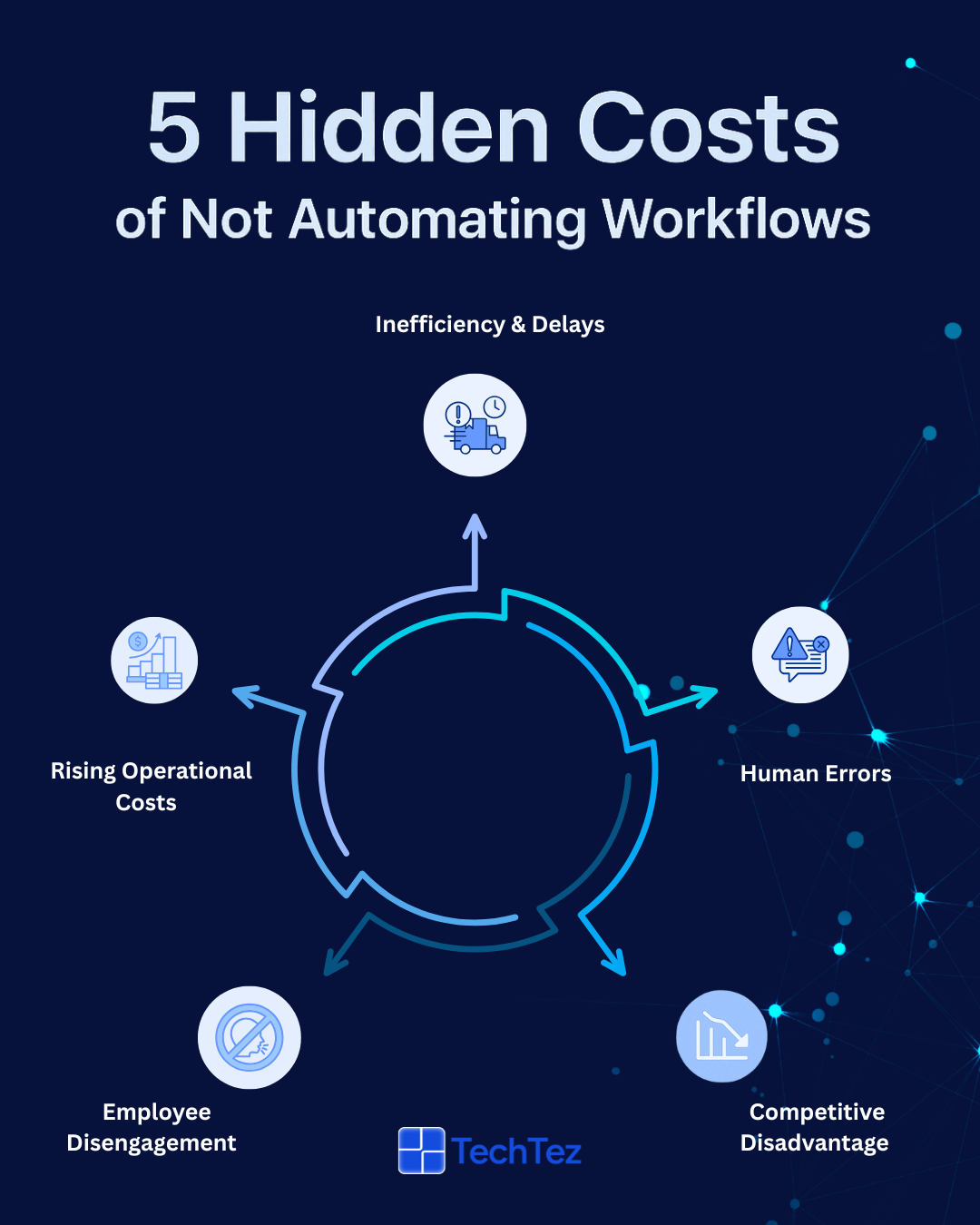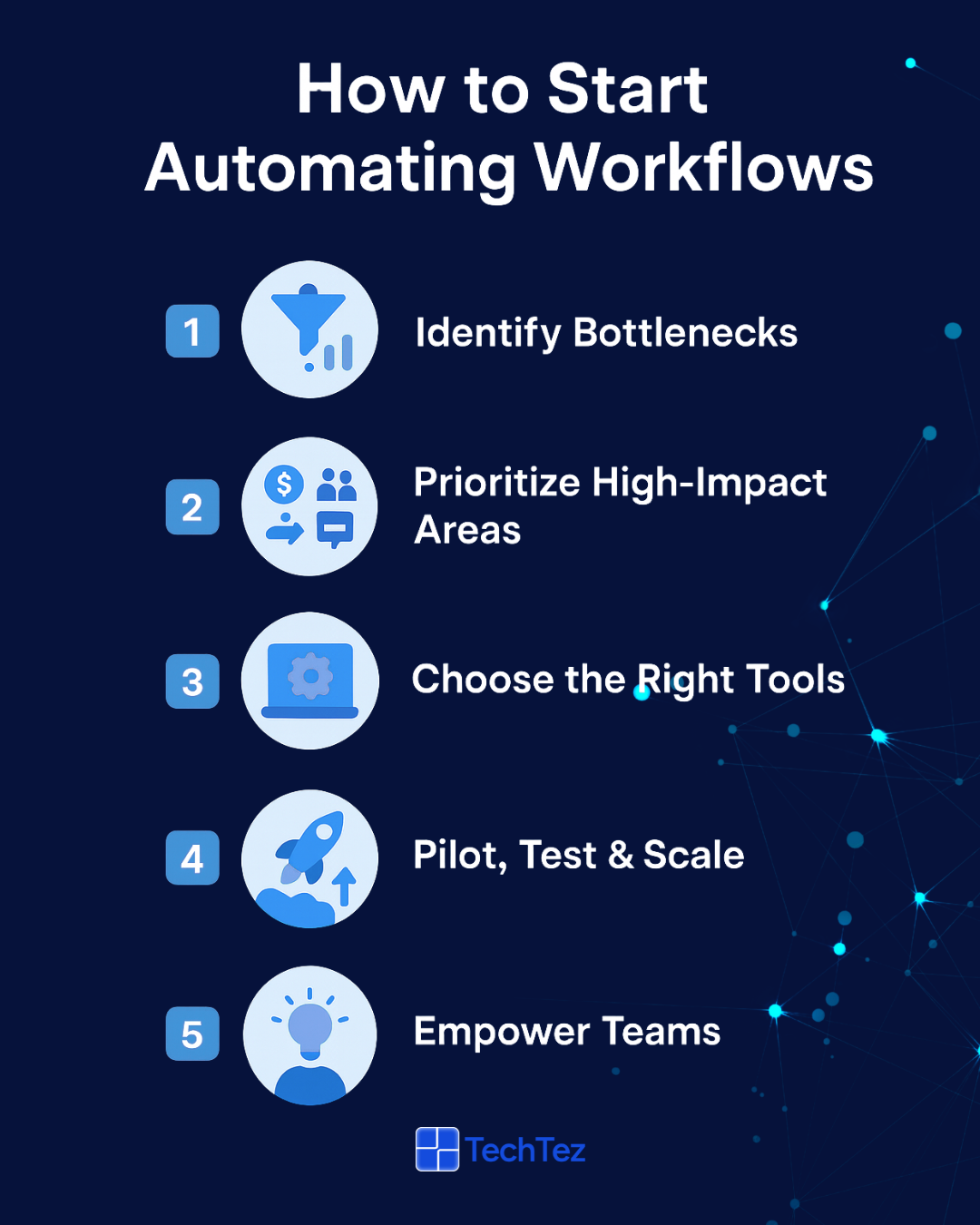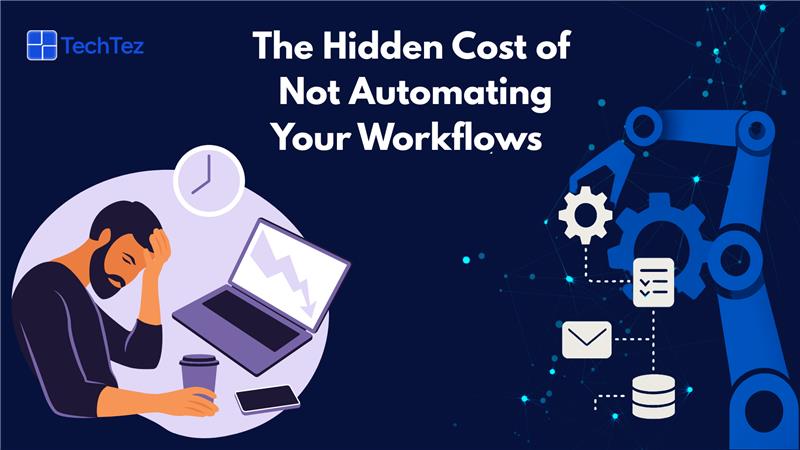Imagine this: Your team spends hours each week chasing approvals on email threads, entering data into spreadsheets, or fixing preventable mistakes. Everyone is working hard, yet deadlines slip, customers wait, and employees feel drained.
This isn’t just inefficiency. It’s the hidden cost of not automating workflows, a cost that compounds every single day.
The real question for businesses is no longer “Should we automate?” but “Can we afford not to?”
What Is Workflow Automation?
Workflow automation is the use of technology to perform repetitive tasks, route information, and streamline processes with minimal human input.
Think of it as hiring a digital co-worker who:
- Sends reminders automatically
- Routes approvals to the right person instantly
- Validates and organizes data accurately
- Ensures nothing slips through the cracks
But here’s the important part: automation doesn’t replace humans, it empowers them. Instead of wasting hours on repetitive grunt work, employees can focus on strategy, creativity, problem-solving, and building stronger customer relationships.
It’s the difference between spending Monday morning reconciling invoices versus brainstorming ways to reduce customer churn.
Why Manual Workflows Cost More Than You Think
Sticking with manual workflows might feel “cheaper” in the short term as you are avoiding software costs, integration, or training investments. But manual processes drain resources silently every single day.
- Lost Time: Employees spend 20 – 30% of their week on repetitive admin tasks.
- Costly Errors: Human mistakes in data entry or approvals snowball into compliance issues and revenue loss.
- Employee Burnout: Talented employees waste energy on grunt work instead of innovation.
- Slow Decisions: Approvals stuck in inboxes delay customer service, hiring, or product launches.
- Missed Opportunities: While you’re busy managing manually, competitors are scaling with automation.
5 Hidden Costs of Not Automating Workflows

1. Inefficiency & Delays
Manual processes drag timelines. What takes hours manually can take minutes with automation.
Example: Automated invoice approvals can flag mismatches instantly, while finance teams stuck with manual checks spend hours chasing signatures and resolving errors.
2. Rising Operational Costs
Repetitive work eats up payroll budgets and slows down ROI.
Example: HR teams manually handle leave requests versus a self-service portal that approves routine leaves instantly.
3. Human Errors
Manual data entry is error prone. Inaccuracies in finance or supply chain cost billions globally.
Example: A mistyped digit in a supply chain order can result in costly inventory shortages or delays.
4. Employee Disengagement
Repetition kills creativity. Teams disengage, attrition rises, and hiring costs escalate.
Example: Engineers spend entire days manually testing code instead of innovating new product features.
5. Competitive Disadvantage
Businesses that automate adapt faster. Those that don’t fall behind.
Example: E-commerce platforms offering automated returns with instant status updates vs. retailers still handling return requests over email.
Benefits of Workflow Automation
Switching to automation brings measurable results:
- Productivity Gains: Workflows that run 24/7, error-free.
- Scalability: Handle more projects/customers without extra headcount.
- Compliance: Built-in audit logs and checks.
- Happier Teams: Employees focus on meaningful, value-driven work.
- Customer Delight: Faster responses and smoother experiences.
Insight💡: According to a 2024 Deloitte study, companies scaling automation saw 32% higher productivity than their peers.
How to Start Automating Workflows

The idea of automating everything at once can feel overwhelming. Instead, businesses should start small and grow smart
Step 1: Identify Bottlenecks
Look for repetitive, time-heavy, error-prone tasks. Examples include invoice processing, HR onboarding, customer ticketing, and IT requests.
Step 2: Prioritize High-Impact Areas
Focus first on departments where automation delivers fast ROI:
- Finance → automated invoice matching
- HR → employee onboarding
- IT → ticket routing and monitoring
- Customer Support → chatbots for FAQs
Step 3: Choose the Right Tools
From RPA (Robotic Process Automation) to AI-driven platforms and non-code solutions, choose tools that match your scale, compliance needs, and growth stage.
Step 4: Pilot, Test & Scale
Start with one workflow, measure results (time saved, errors reduced, ROI gained), then expand to other processes.
Step 5: Empower Teams
Automation succeeds when employees see it as an enabler, not a threat. Provide training and highlight how automation frees them to focus on creative, impactful work.
The ROI of Workflow Automation
When companies think about automation, the first concern is often the cost of implementation. But the reality is, the return on investment (ROI) is often exponential and measurable in ways that go beyond money.
Let’s break down how automation pays for itself:
1. Direct Financial Savings
The most obvious ROI is reduced operational costs. Tasks that once required multiple employees can now be handled by AI bots or automation tools at a fraction of the cost.
Insight💡: According to Gartner, organizations implementing automation reported an average cost reduction of 24–30% in targeted processes within the first year.
2. Time Savings That Scale
Time is the most valuable currency in business. Every hour reclaimed from manual work can be reinvested into higher-value activities like innovation, customer service, or product development.
Insight💡: McKinsey found that automation technologies could free up to 20% of a company’s total workforce hours.
3. Error Reduction = Risk Reduction
Every human error in finance, healthcare, or compliance has a cost attached not just monetary but reputational.
Automation introduces accuracy and consistency. Bots don’t get tired, distracted, or make typos. This reduces financial leaks, compliance penalties, and rework costs.
4. Employee Productivity & Morale
ROI isn’t only financial, it’s also cultural. Employees freed from repetitive work report higher job satisfaction and engagement. This directly lowers turnover and recruitment costs.
Insight💡: Deloitte’s 2023 Global Human Capital Trends report revealed that employees in companies adopting automation were 2.3x more likely to feel fulfilled in their jobs.
5. Customer Experience as ROI
Happy customers = higher revenue. Faster response times, smoother processes, and fewer errors all translate into better customer loyalty and retention.
6. Strategic Advantage
Beyond day-to-day efficiency, automation builds long-term competitive advantage.
Companies that automate first can:
- Enter markets faster
- Deliver products at lower cost
- Pivot more easily to new opportunities
Calculating Your ROI
To build the business case, organizations can start with this simple formula:
ROI (%) = (Annual Savings – Automation Costs) ÷ Automation Costs × 100
Where savings come from:
- Labor costs reduced
- Error costs avoided
- Compliance fines prevented
- New revenue opportunities unlocked
Why ROI Isn’t Just About Money
Yes, automation saves money. But the real ROI lies in:
- Agility: Ability to respond to change faster
- Innovation: Freeing talent for higher-value work
- Trust: Compliance and customer confidence
- Resilience: Business continuity during disruptions
In a world where markets shift overnight, automation is less an expense and more an insurance policy for long-term survival.
Everyday Examples of Workflow Automation
- Slack bots handling leave approvals
- AI-powered testing tools accelerating software releases
- Finance bots matching invoices with purchase orders
- Automated customer support chatbots resolving FAQs instantly
Even small steps like automating meeting scheduling save hours every week.
The Future of Workflow Automation
The future isn’t about humans being replaced. It’s about humans + automation working smarter together.
This is how:
- Sales teams focusing purely on customer relationships while bots update the CRM.
- Hospitals where patient data flows instantly and securely to the right doctors.
- IT systems diagnosing and fixing network issues with AI-powered insights.
The organizations that thrive will be the ones that embrace automation early and scale it responsibly.
Final Thoughts: Automate or Fall Behind
The hidden cost of not automating workflows is silent but severe: wasted time, lost money, demotivated employees, and lagging competitors.
Automation isn’t just a trend. It’s the foundation of future-ready businesses.
The best time to start automating was yesterday. The second-best time is today.
FAQs on Workflow Automation
- What happens if a business doesn’t automate workflows?
Businesses risk wasted time, higher costs, employee burnout, costly errors, and losing competitive advantage. - What are the biggest benefits of workflow automation?
Automation boosts productivity, reduces manual errors, improves compliance, lowers costs, and frees teams for high-value work. - Does workflow automation replace jobs?
No. It’s designed to take over repetitive tasks so employees can focus on creative, strategic, and customer-facing roles. - Which workflows should be automated first?
High-volume, repetitive tasks in finance (invoice approvals), HR (leave requests), IT (ticketing), and customer service (FAQs) deliver the fastest ROI. - How much time can workflow automation save?
Studies show employees can reclaim up to 30% of their time by automating repetitive processes. - Is automation only for large enterprises?
Not at all. Small and medium businesses benefit equally, automation helps them scale without adding extra headcount.
Need Help Automating?
At Techtez, we help businesses design and deploy automation strategies that boost productivity, cut costs, and scale with confidence.
Get in touch with our AI & Automation Architects today. Drop us an email at info@techtez.com
